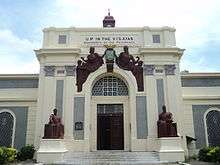University of the Philippines Visayas Tacloban College
| Unibersidad han Pilipinas ha Kabisay-an Kolehiyo ha Tacloban | |
|
| |
| Motto | Honor and Excellence |
|---|---|
| Type | National university |
| Established |
1908 (U.P. system) 1973 (campus) |
| Chancellor | Dr. Rommel A. Espinosa |
| President | Alfredo E. Pascual |
| Dean | Dr. Virgildo E. Sabalo (OIC) |
| Location |
Tacloban, Philippines 11°14′54″N 125°0′26″E / 11.24833°N 125.00722°ECoordinates: 11°14′54″N 125°0′26″E / 11.24833°N 125.00722°E |
| Hymn | U.P. Naming Mahal |
| Nickname | UP Tac, UPVTC |
| Mascot | U.P. Oblation |
| Website |
www |
The University of the Philippines Visayas Tacloban College (UPVTC) is a university in the Philippines.
A satellite college of the University of the Philippines, it was established on May 23, 1973 as part of the University of the Philippines Visayas.
History
In its 823rd meeting, the University of the Philippines (UP) Board of Regents established the UP College Tacloban. It was recognized as a regional unit of the System on May 23, 1973 and inaugurated on July 2, 1973.
Ten years later, Executive Order No. 4 placed UP College Tacloban under the administrative supervision of University of the Philippines Visayas.
Admissions
UP College Admission Test (UPCAT)
Admission into the University of the Philippines' undergraduate programs is very competitive, with over 70,000 students taking the exam every year, with about 11,000 being accepted. To maintain its high standard of education and to maximize its limited resources, UP has had to limit slots for undergraduate admission to each campus and to its various degree programs by means of qualification through the University of the Philippines College Admission Test (UPCAT).
Organization
UPV Tacloban College (UPVTC) is divided into four divisions:
- Division of Humanities
- Division of Management
- Division of Natural Sciences and Mathematics
- Division of Social Sciences
Academic Programs
The college's BS Accountancy, BS Biology, and BS Computer Science programs are currently the best in Region 8. The college's BA Communication Arts program is the finest in the Visayan archipelago in terms of Speech, Literature and Theater Arts. The BA Psychology program has also been recently recognized in The Psychological Association of the Philippines-Junior Affiliates (PAPJA).
Undergraduate
- Bachelor of Arts in Communication Arts
- Bachelor of Arts in Psychology
- Bachelor of Arts in Social Sciences with specialization in Economics
- Bachelor of Arts in Social Sciences with specialization in Political Science
- Bachelor of Science in Accountancy (5 years)
- Bachelor of Science in Biology
- Bachelor of Science in Computer Science
- Bachelor of Science in Management
Graduate
- Master of Management (Business Management)
- Master of Management (Public Management)
Student Life
Student Body
UPVTC Student Body is autonomous student body and has a student council subject only to the express will of the students. There are morethan 2000 students currently enrolled and has 48 student organizations. All bona fide undergraduate students of the UPV Tacloban College are considered members of the UPV Tacloban College student body.
UPVTC STUDENT COUNCIL
UPVTC Student Council is the policy-making body in between sessions of the General Assembly. It is considered independent and need not to be recognized by the Office of the Student Affairs. The selection if its officers is annual and via students' election.
Chairperson: Ken Seco
Vice-Chairperson: Alfonso Alex Labrague
Secretary-General: Norvelyn Capaycapay
Finance Officer: Kent Pingol
Public Information Officer: Mira Legion
Committee on Students' Right and Welfare: Nikko Gabriel Aquino
Committee on Disaster Risk Reduction and Environment: Daryll Clark Castillo
Committee on Sports: Seven Encio
Committee on Arts and Culture: Pierre Dan Ampo
Committee on People's Struggle's Desk: Marielle Domequil
Committee on Students' Organizations, Fraternities and Sororities: Jacqueline Amistoso
Division Representatives
Humanities: Czarina Vanelli Piñon
Natural Sciences and Mathematics: Joelson Pilapil
Management: Nova Venezuela
Social Sciences: Lorie Lugasan
UPVSC Representatives
Joshua Sagdullas
Alain Gerard Aclan
Gian Paolo Brilata
Nelson Mora
STUDENT ORGANIZATIONS
There are 48 college recognized organizations, which includes geological-based organizations (e.g. OrSiCUP, KAISSA, HINGYAP, etc.), socio-civic (UP Runggiyan, Halciyon, etc.), interests (Animo, Amplify UP, etc.), fraternities and sororities, (TGP, TOM, APO), political parties (PULSO han mag-aaram, etc), and others. Student organizations were formed by students with common interest and has its own constitutions, rules and activities. Student organizations will only be considered by the college of it comply and abide rules set by the university and by the college.

